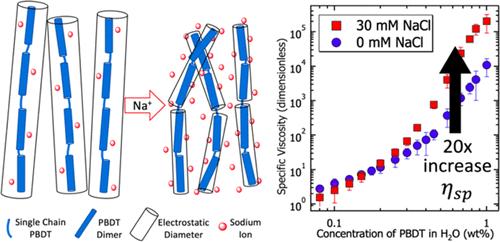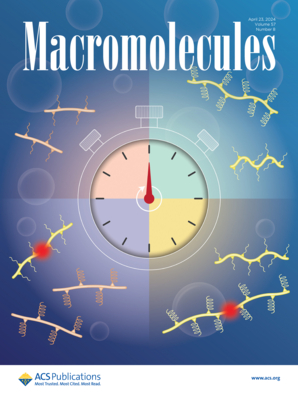Increasing Viscosity of a Rodlike Polyelectrolyte Solution with a Monovalent Salt
IF 5.1
1区 化学
Q1 POLYMER SCIENCE
引用次数: 0
Abstract
The behavior of a synthetic self-assembled rodlike polyelectrolyte is investigated both in salt-free solutions and in the presence of monovalent salt. The inherent rigidity and rodlike nature of poly(2,2′-disulfonyl-4,4′-benzidine terephthalamide) (PBDT) in salt-free aqueous solutions results in a nematic liquid-crystalline transition at a 1.0 wt % concentration. Specific viscosity ηsp of PBDT scales with concentration (c) as ηsp ∼ c1.2 in semidilute salt-free solutions, which deviates from the behavior of most semidilute polyelectrolyte solutions that follow Fuoss law (ηsp ∼ c0.5). Additionally, PBDT solutions containing 30 mM NaCl reveal a crossover concentration (c > cx) and show up to a greater than 20-fold increase in ηsp compared with salt-free PBDT solutions at the same concentration. Oscillatory rheology experiments display a rise in modulus at all frequencies for PBDT solutions containing 10 mM NaCl and above, suggesting an increase in rod–rod association strength. X-ray scattering studies in salt-free semidilute PBDT solutions reveal polyelectrolyte correlation length (ξ) scaling as ε ∼ c–0.43±0.03, which is a weaker dependence than typical scaling (ξ ∼ c–1/2) due to the balance of electrostatic and associative intermolecular interactions. We propose that PBDT can serve as a synthetic model system for studying the solution behavior of associative rodlike polyelectrolytes.

求助全文
约1分钟内获得全文
求助全文
来源期刊

Macromolecules
工程技术-高分子科学
CiteScore
9.30
自引率
16.40%
发文量
942
审稿时长
2 months
期刊介绍:
Macromolecules publishes original, fundamental, and impactful research on all aspects of polymer science. Topics of interest include synthesis (e.g., controlled polymerizations, polymerization catalysis, post polymerization modification, new monomer structures and polymer architectures, and polymerization mechanisms/kinetics analysis); phase behavior, thermodynamics, dynamic, and ordering/disordering phenomena (e.g., self-assembly, gelation, crystallization, solution/melt/solid-state characteristics); structure and properties (e.g., mechanical and rheological properties, surface/interfacial characteristics, electronic and transport properties); new state of the art characterization (e.g., spectroscopy, scattering, microscopy, rheology), simulation (e.g., Monte Carlo, molecular dynamics, multi-scale/coarse-grained modeling), and theoretical methods. Renewable/sustainable polymers, polymer networks, responsive polymers, electro-, magneto- and opto-active macromolecules, inorganic polymers, charge-transporting polymers (ion-containing, semiconducting, and conducting), nanostructured polymers, and polymer composites are also of interest. Typical papers published in Macromolecules showcase important and innovative concepts, experimental methods/observations, and theoretical/computational approaches that demonstrate a fundamental advance in the understanding of polymers.
 求助内容:
求助内容: 应助结果提醒方式:
应助结果提醒方式:


